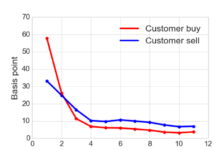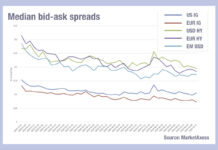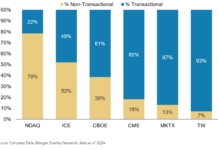
As buy-side firms look to increase their exposure to credit futures, market operators find ways to support access.
The DESK spoke with David Litchfield, director for derivatives sales at Cboe Global Markets, about the paths to expanding notional and tickets traded in the credit index futures market, and the advantages this is conferring on investors.
How is Cboe expanding liquidity support for credit futures traders?
We have released functionality that allows the execution of the futures to be tied explicitly with the execution of ETFs. In the credit space, where people are assessing the liquidity of the futures market, this will give clients comfort to trade in very large size. We have two Tier 1 global banks live and a Tier 1 European bank, allowing clients to reach out for three prices which many need to support their best execution goals.
We have more sell-side counterparties coming online all the time with this ability to link explicitly the futures execution with the ETFs. In today’s market, with the open interest that we have and natural volumes on screen, we are organically building the product but to turbo charge it, that’s where the block market comes into play. Previously, participants could only ask a dealer for a risk price, meaning the dealer is then exposed to risk if the market moves before they’ve hedged themselves, and the dealers have to price that into the risk price.
How does the new functionality change that workflow?
Very few clients need instant execution, so they can now ask the dealer to quote against a worked delta. They can reference the ETF and with the HYG ETF, for example, at a given price, ask where the dealer will make them the corresponding future’s price. The dealer can then work the ETF hedge once the price is agreed. That could be, for example, over the next hour with a volume-weighted average price (VWAP), or work the ETF hedge with a limit price or any other cash instruction. The movements of that ETF hedge are simply passed through to the futures price. Say that a dealer makes the high yield future (IBHY) 149 at 150 with HYG at 75. If the ETF execution comes in at 80, the client gets filled on futures at 160. If the ETF price gets done at 70, well, they get filled in futures at 140. They’re pre-agreeing the price of the futures, based on the ETF level. As a result, the execution and the liquidity that the client needs to be concerned about is therefore 100% in ETFs, which they know trades US$3 billion a day at a penny wide. The only liquidity they really need to care about is liquidity in the ETFs because of this functionality.
What level of liquidity do clients typically want to see to engage?
That functionality came online in March, and it should turbo charge the open interest. If we see good ticket sizes traded, the open interest increases, and customers sometimes need the open interest to be a minimum level before they can start participating. For example, some customers are limited to a percentage of open interest; 10% is quite a common number. The greater the notional traded, the more they can participate and once everyone comes to the party, there is the snowball effect on scale.
What is the perception of liquidity today?
Unfortunately it still doesn’t tally with reality! The raw numbers visibly on screen belie the true liquidity. However, for those already participating, we’re seeing greater confidence in the screen liquidity. This new mechanism of enabling the explicit execution of the ETF is going to support that confidence, and see bigger players – new entrants to the market.
How is engagement building and across which market areas?
We’ve seen a lot of interest from hedge funds, like CTAs, along with long-only buy-side firms. A lot of them are still tied to trading credit default index swaps (CDX), and operate in that market. That will continue because they have muscle memory in trading those instruments. But they would like to trade futures as and when liquidity and open interest is supportive. A lot of buy-side firms are not able to be first movers, or to trade five times open interest, so they need to use a product once it’s established.
Those buy-side firms willing to dive in are not necessarily as wedded to that credit world where they trade OTC products. For example, asset managers that run a lot of wealth money, either in multiple, different segregated mandates, or mandates that are not allowed to use OTC derivatives. Even in the larger firms, there are often charities and other institutions that do not want OTC derivatives to be used. That’s where futures are an absolutely perfect vehicle, because the manager can trade 100 futures and divide that trade up between accounts, splitting the trade into fairly small notional sizes rather than having to trade 100 swaps. That is where we see a huge amount of initial interest which will be the first over the line.
Those wealth managers are important in the first step, because they have accounts that are small enough to trade against the current (perceived) liquidity, but they also have very large accounts, and they can scale into those quickly. The derived block functionality is a very good catalyst for that.
How is the current rate environment playing into the use of these futures?
Duration obviously plays a bigger part than is has done during the lower-for-longer days. These futures are analogous with an index of cash bonds, in the same way the S&P 500 is an index of cash equities. If one has a bond portfolio, one wants to be hedging something that replicates bonds, converse to a CDS index that only has that spread component. There is a part of the market that only wants the credit, because those investors are looking at the alpha component for their trade, and duration is a completely secondary component that’s managed separately in their portfolio.
The uncertainty around the interest rate environment plays into the use case of the futures because one can hedge cash bonds with a cash bond instrument that has the duration. If one just wants the credit spreads, hedging out the duration using treasuries, futures or cash is pretty straightforward.
Every single future has an implied financing curve. The money that one gets from a 90-day treasury is greater at the moment than the effective rate one is paying for in the futures. So the long holder of the futures gets that pick up. Different players are brought in for different use cases, either locking in very favourable rates on the long side, or locking in very favourable rates on the short side to implement a hedge.
How could capital pressures on banks drive people towards futures?
Freeing up an OTC line by taking off a CDS index and putting it into a listed product helps the OTC budget. In a similar vein, using the iBoxx futures that don’t incur a fee, can help free up some of that fee budget. The Fundamental Review of the Trading Book (FRTB), could bring an important use case for the sell side. Capital required to be held against the bond trading business has been in the spotlight since 2008/2009. If under the Fundamental Review of the Trading Book, a bank’s bond dealing desk can get relief from market P&L swings by using an instrument to hedge, and that is something the futures and the options could then play a significant part in anecdotally there seems to be something there.
©Markets Media Europe 2023























